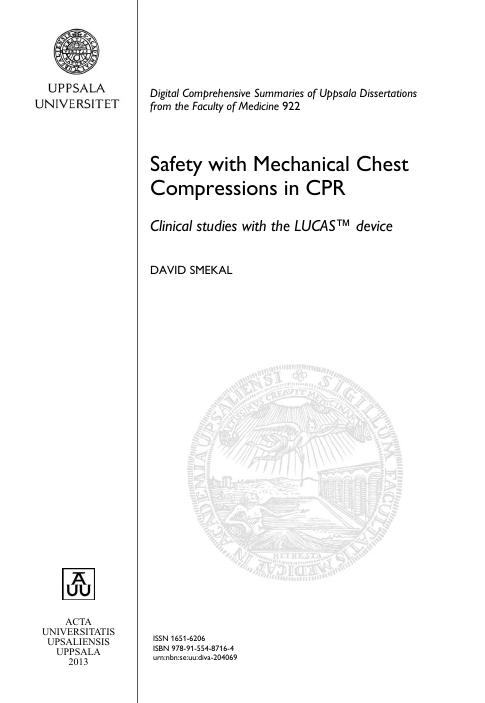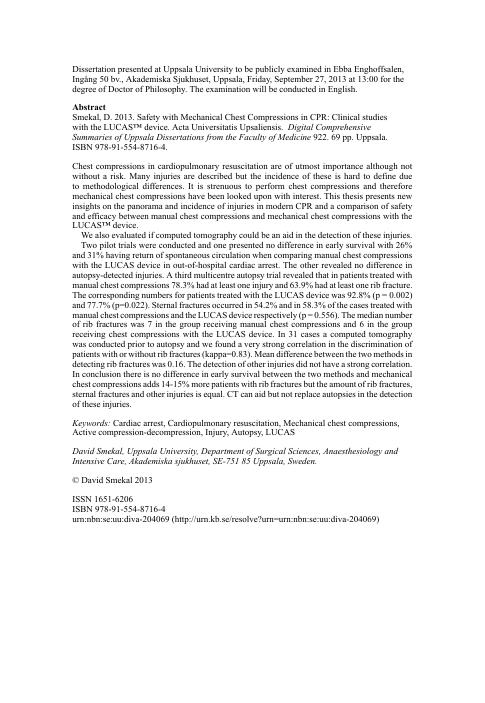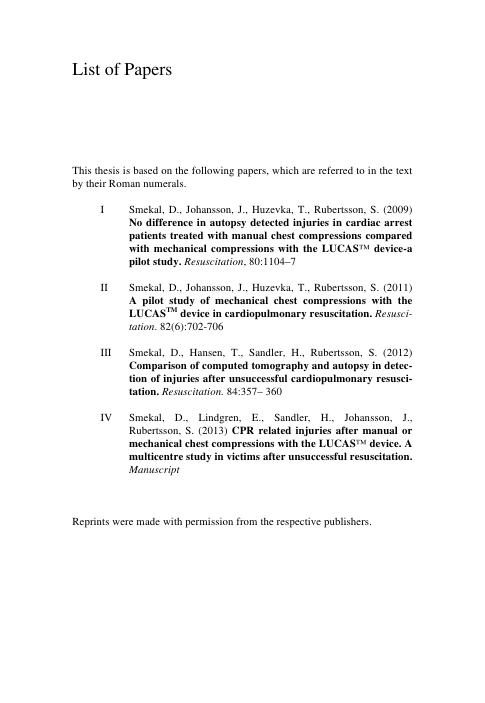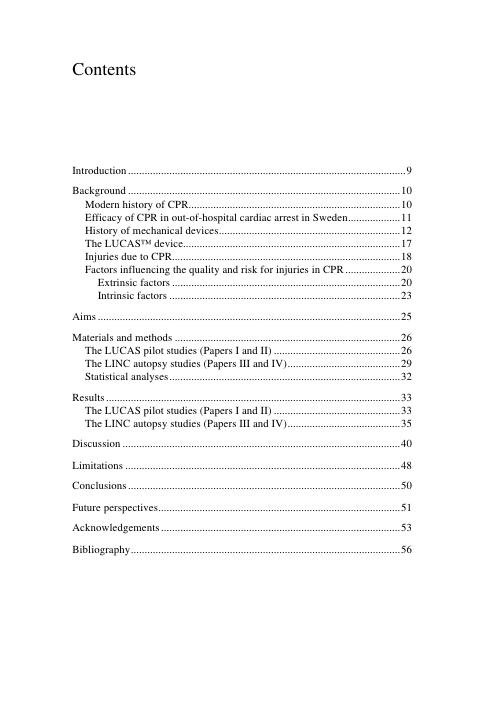Safety with Mechanical Chest Compressions in CPR: Clinical studies with the LUCAS™ device
Added on 2023-06-15
70 Pages21472 Words64 Views
ACTA
UNIVERSITATIS
UPSALIENSIS
UPPSALA
2013
Digital Comprehensive Summaries of Uppsala Dissertations
from the Faculty of Medicine 922
Safety with Mechanical Chest
Compressions in CPR
Clinical studies with the LUCAS™ device
DAVID SMEKAL
ISSN 1651-6206
ISBN 978-91-554-8716-4
urn:nbn:se:uu:diva-204069
UNIVERSITATIS
UPSALIENSIS
UPPSALA
2013
Digital Comprehensive Summaries of Uppsala Dissertations
from the Faculty of Medicine 922
Safety with Mechanical Chest
Compressions in CPR
Clinical studies with the LUCAS™ device
DAVID SMEKAL
ISSN 1651-6206
ISBN 978-91-554-8716-4
urn:nbn:se:uu:diva-204069

Dissertation presented at Uppsala University to be publicly examined in Ebba Enghoffsalen,
Ingång 50 bv., Akademiska Sjukhuset, Uppsala, Friday, September 27, 2013 at 13:00 for the
degree of Doctor of Philosophy. The examination will be conducted in English.
Abstract
Smekal, D. 2013. Safety with Mechanical Chest Compressions in CPR: Clinical studies
with the LUCAS™ device. Acta Universitatis Upsaliensis. Digital Comprehensive
Summaries of Uppsala Dissertations from the Faculty of Medicine 922. 69 pp. Uppsala.
ISBN 978-91-554-8716-4.
Chest compressions in cardiopulmonary resuscitation are of utmost importance although not
without a risk. Many injuries are described but the incidence of these is hard to define due
to methodological differences. It is strenuous to perform chest compressions and therefore
mechanical chest compressions have been looked upon with interest. This thesis presents new
insights on the panorama and incidence of injuries in modern CPR and a comparison of safety
and efficacy between manual chest compressions and mechanical chest compressions with the
LUCAS™ device.
We also evaluated if computed tomography could be an aid in the detection of these injuries.
Two pilot trials were conducted and one presented no difference in early survival with 26%
and 31% having return of spontaneous circulation when comparing manual chest compressions
with the LUCAS device in out-of-hospital cardiac arrest. The other revealed no difference in
autopsy-detected injuries. A third multicentre autopsy trial revealed that in patients treated with
manual chest compressions 78.3% had at least one injury and 63.9% had at least one rib fracture.
The corresponding numbers for patients treated with the LUCAS device was 92.8% (p = 0.002)
and 77.7% (p=0.022). Sternal fractures occurred in 54.2% and in 58.3% of the cases treated with
manual chest compressions and the LUCAS device respectively (p = 0.556). The median number
of rib fractures was 7 in the group receiving manual chest compressions and 6 in the group
receiving chest compressions with the LUCAS device. In 31 cases a computed tomography
was conducted prior to autopsy and we found a very strong correlation in the discrimination of
patients with or without rib fractures (kappa=0.83). Mean difference between the two methods in
detecting rib fractures was 0.16. The detection of other injuries did not have a strong correlation.
In conclusion there is no difference in early survival between the two methods and mechanical
chest compressions adds 14-15% more patients with rib fractures but the amount of rib fractures,
sternal fractures and other injuries is equal. CT can aid but not replace autopsies in the detection
of these injuries.
Keywords: Cardiac arrest, Cardiopulmonary resuscitation, Mechanical chest compressions,
Active compression-decompression, Injury, Autopsy, LUCAS
David Smekal, Uppsala University, Department of Surgical Sciences, Anaesthesiology and
Intensive Care, Akademiska sjukhuset, SE-751 85 Uppsala, Sweden.
© David Smekal 2013
ISSN 1651-6206
ISBN 978-91-554-8716-4
urn:nbn:se:uu:diva-204069 (http://urn.kb.se/resolve?urn=urn:nbn:se:uu:diva-204069)
Ingång 50 bv., Akademiska Sjukhuset, Uppsala, Friday, September 27, 2013 at 13:00 for the
degree of Doctor of Philosophy. The examination will be conducted in English.
Abstract
Smekal, D. 2013. Safety with Mechanical Chest Compressions in CPR: Clinical studies
with the LUCAS™ device. Acta Universitatis Upsaliensis. Digital Comprehensive
Summaries of Uppsala Dissertations from the Faculty of Medicine 922. 69 pp. Uppsala.
ISBN 978-91-554-8716-4.
Chest compressions in cardiopulmonary resuscitation are of utmost importance although not
without a risk. Many injuries are described but the incidence of these is hard to define due
to methodological differences. It is strenuous to perform chest compressions and therefore
mechanical chest compressions have been looked upon with interest. This thesis presents new
insights on the panorama and incidence of injuries in modern CPR and a comparison of safety
and efficacy between manual chest compressions and mechanical chest compressions with the
LUCAS™ device.
We also evaluated if computed tomography could be an aid in the detection of these injuries.
Two pilot trials were conducted and one presented no difference in early survival with 26%
and 31% having return of spontaneous circulation when comparing manual chest compressions
with the LUCAS device in out-of-hospital cardiac arrest. The other revealed no difference in
autopsy-detected injuries. A third multicentre autopsy trial revealed that in patients treated with
manual chest compressions 78.3% had at least one injury and 63.9% had at least one rib fracture.
The corresponding numbers for patients treated with the LUCAS device was 92.8% (p = 0.002)
and 77.7% (p=0.022). Sternal fractures occurred in 54.2% and in 58.3% of the cases treated with
manual chest compressions and the LUCAS device respectively (p = 0.556). The median number
of rib fractures was 7 in the group receiving manual chest compressions and 6 in the group
receiving chest compressions with the LUCAS device. In 31 cases a computed tomography
was conducted prior to autopsy and we found a very strong correlation in the discrimination of
patients with or without rib fractures (kappa=0.83). Mean difference between the two methods in
detecting rib fractures was 0.16. The detection of other injuries did not have a strong correlation.
In conclusion there is no difference in early survival between the two methods and mechanical
chest compressions adds 14-15% more patients with rib fractures but the amount of rib fractures,
sternal fractures and other injuries is equal. CT can aid but not replace autopsies in the detection
of these injuries.
Keywords: Cardiac arrest, Cardiopulmonary resuscitation, Mechanical chest compressions,
Active compression-decompression, Injury, Autopsy, LUCAS
David Smekal, Uppsala University, Department of Surgical Sciences, Anaesthesiology and
Intensive Care, Akademiska sjukhuset, SE-751 85 Uppsala, Sweden.
© David Smekal 2013
ISSN 1651-6206
ISBN 978-91-554-8716-4
urn:nbn:se:uu:diva-204069 (http://urn.kb.se/resolve?urn=urn:nbn:se:uu:diva-204069)

“Life is short, and Art long; the crisis fleeting; experience perilous, and deci-
sion difficult. The physician must not only be prepared to do what is right
himself, but also to make the patient, the attendants, and externals cooperate.”
Hippocrates 400 BC
To those I care about
sion difficult. The physician must not only be prepared to do what is right
himself, but also to make the patient, the attendants, and externals cooperate.”
Hippocrates 400 BC
To those I care about


List of Papers
This thesis is based on the following papers, which are referred to in the text
by their Roman numerals.
I Smekal, D., Johansson, J., Huzevka, T., Rubertsson, S. (2009)
No difference in autopsy detected injuries in cardiac arrest
patients treated with manual chest compressions compared
with mechanical compressions with the LUCAS™ device-a
pilot study. Resuscitation, 80:1104–7
II Smekal, D., Johansson, J., Huzevka, T., Rubertsson, S. (2011)
A pilot study of mechanical chest compressions with the
LUCASTM device in cardiopulmonary resuscitation. Resusci-
tation. 82(6):702-706
III Smekal, D., Hansen, T., Sandler, H., Rubertsson, S. (2012)
Comparison of computed tomography and autopsy in detec-
tion of injuries after unsuccessful cardiopulmonary resusci-
tation. Resuscitation. 84:357– 360
IV Smekal, D., Lindgren, E., Sandler, H., Johansson, J.,
Rubertsson, S. (2013) CPR related injuries after manual or
mechanical chest compressions with the LUCAS™ device. A
multicentre study in victims after unsuccessful resuscitation.
Manuscript
Reprints were made with permission from the respective publishers.
This thesis is based on the following papers, which are referred to in the text
by their Roman numerals.
I Smekal, D., Johansson, J., Huzevka, T., Rubertsson, S. (2009)
No difference in autopsy detected injuries in cardiac arrest
patients treated with manual chest compressions compared
with mechanical compressions with the LUCAS™ device-a
pilot study. Resuscitation, 80:1104–7
II Smekal, D., Johansson, J., Huzevka, T., Rubertsson, S. (2011)
A pilot study of mechanical chest compressions with the
LUCASTM device in cardiopulmonary resuscitation. Resusci-
tation. 82(6):702-706
III Smekal, D., Hansen, T., Sandler, H., Rubertsson, S. (2012)
Comparison of computed tomography and autopsy in detec-
tion of injuries after unsuccessful cardiopulmonary resusci-
tation. Resuscitation. 84:357– 360
IV Smekal, D., Lindgren, E., Sandler, H., Johansson, J.,
Rubertsson, S. (2013) CPR related injuries after manual or
mechanical chest compressions with the LUCAS™ device. A
multicentre study in victims after unsuccessful resuscitation.
Manuscript
Reprints were made with permission from the respective publishers.


Contents
Introduction ..................................................................................................... 9
Background ................................................................................................... 10
Modern history of CPR............................................................................. 10
Efficacy of CPR in out-of-hospital cardiac arrest in Sweden ................... 11
History of mechanical devices .................................................................. 12
The LUCAS™ device............................................................................... 17
Injuries due to CPR................................................................................... 18
Factors influencing the quality and risk for injuries in CPR .................... 20
Extrinsic factors ................................................................................... 20
Intrinsic factors .................................................................................... 23
Aims .............................................................................................................. 25
Materials and methods .................................................................................. 26
The LUCAS pilot studies (Papers I and II) .............................................. 26
The LINC autopsy studies (Papers III and IV) ......................................... 29
Statistical analyses .................................................................................... 32
Results ........................................................................................................... 33
The LUCAS pilot studies (Papers I and II) .............................................. 33
The LINC autopsy studies (Papers III and IV) ......................................... 35
Discussion ..................................................................................................... 40
Limitations .................................................................................................... 48
Conclusions ................................................................................................... 50
Future perspectives ........................................................................................ 51
Acknowledgements ....................................................................................... 53
Bibliography .................................................................................................. 56
Introduction ..................................................................................................... 9
Background ................................................................................................... 10
Modern history of CPR............................................................................. 10
Efficacy of CPR in out-of-hospital cardiac arrest in Sweden ................... 11
History of mechanical devices .................................................................. 12
The LUCAS™ device............................................................................... 17
Injuries due to CPR................................................................................... 18
Factors influencing the quality and risk for injuries in CPR .................... 20
Extrinsic factors ................................................................................... 20
Intrinsic factors .................................................................................... 23
Aims .............................................................................................................. 25
Materials and methods .................................................................................. 26
The LUCAS pilot studies (Papers I and II) .............................................. 26
The LINC autopsy studies (Papers III and IV) ......................................... 29
Statistical analyses .................................................................................... 32
Results ........................................................................................................... 33
The LUCAS pilot studies (Papers I and II) .............................................. 33
The LINC autopsy studies (Papers III and IV) ......................................... 35
Discussion ..................................................................................................... 40
Limitations .................................................................................................... 48
Conclusions ................................................................................................... 50
Future perspectives ........................................................................................ 51
Acknowledgements ....................................................................................... 53
Bibliography .................................................................................................. 56

Abbreviations
ACD-CPR Active compression-decompression-CPR
AHA American Heart Association
ALS Advanced life support
BLS Basic life support
BP Blood pressure
CPR Cardiopulmonary resuscitation
CT Computed tomography
ECG Electrocardiography
ECMO Extracorporeal membrane oxygenation
EMS Emergency medical system
ERC European Resuscitation Council
ICU Intensive care unit
L-CPR LUCAS CPR
MCC Miniaturized mechanical chest compressor
M-CPR Manual CPR
OHCA Out-of-hospital cardiac arrest
PACS Picture archiving and communication system
PCI Percutaneous coronary intervention
PETCO2 Partial pressure of end-tidal carbon dioxide
ROSC Return of spontaneous circulation
ACD-CPR Active compression-decompression-CPR
AHA American Heart Association
ALS Advanced life support
BLS Basic life support
BP Blood pressure
CPR Cardiopulmonary resuscitation
CT Computed tomography
ECG Electrocardiography
ECMO Extracorporeal membrane oxygenation
EMS Emergency medical system
ERC European Resuscitation Council
ICU Intensive care unit
L-CPR LUCAS CPR
MCC Miniaturized mechanical chest compressor
M-CPR Manual CPR
OHCA Out-of-hospital cardiac arrest
PACS Picture archiving and communication system
PCI Percutaneous coronary intervention
PETCO2 Partial pressure of end-tidal carbon dioxide
ROSC Return of spontaneous circulation

End of preview
Want to access all the pages? Upload your documents or become a member.
